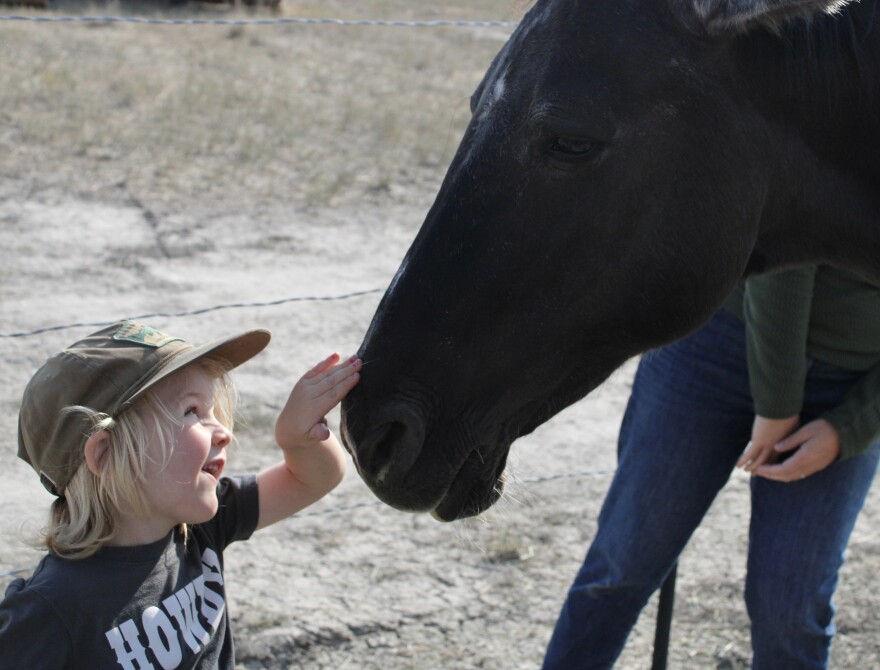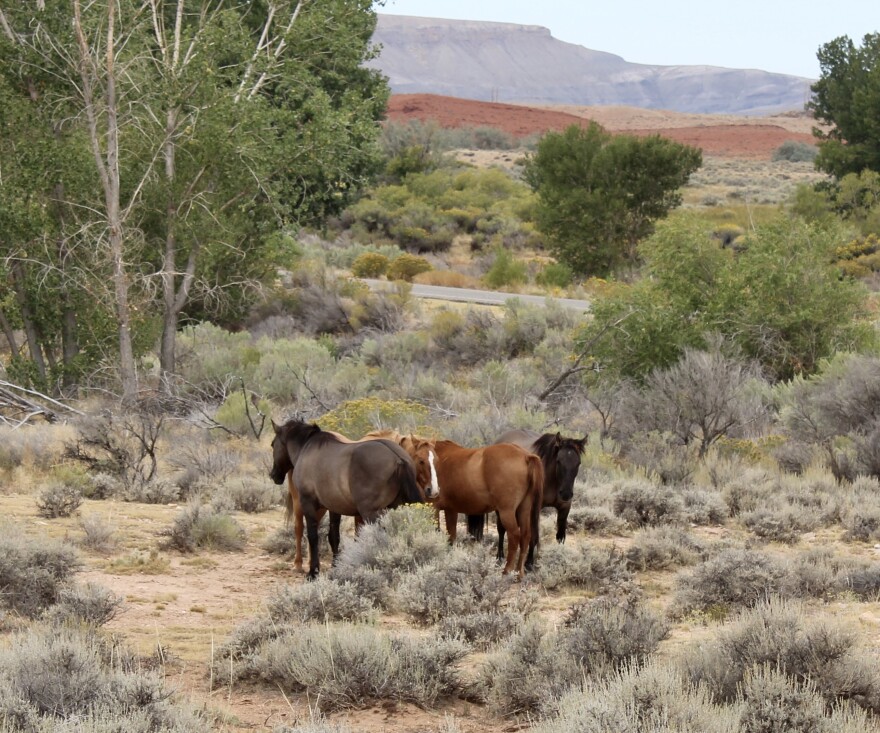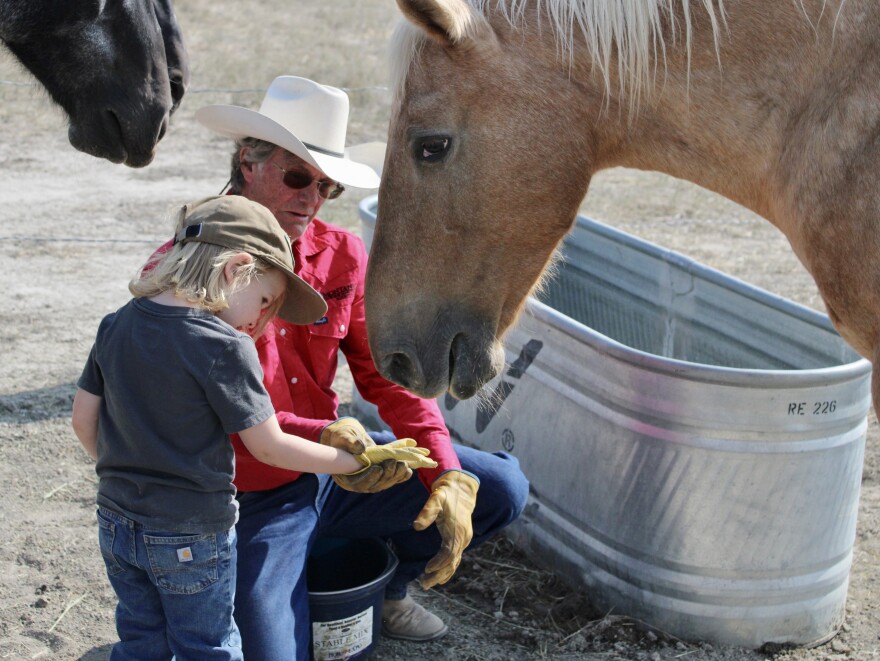This week: A second edition of "The Little Why," where we tackle questions from our younger listeners. Saddle up, grab the reins and ride along with us as we learn about wild horses in Montana.
Austin Amestoy Welcome to The Big Why, a series from Montana Public Radio where we find out what we can discover together. I'm your host, Austin Amestoy, and today we have something very special for you: A second edition of The Little Why, where we tackle questions from our younger listeners. We have reporter Shaylee Rager here with us today. Hi, Shaylee.
Shaylee Ragar Hey Austin.
Austin Amestoy So I believe you have a question from a little friend in Helena.
Shaylee Ragar Yes, three-year-old Henry Bridge.
Henry Bridge Hello.
Shaylee Ragar He is super smart and curious and has taken a special interest in one animal in particular. In fact, he has a toy box full of models.
Henry Bridge See this ... is a buckskin.
Austin Amestoy Oh, a buckskin, so we're talking horses today, I take it.
Shaylee Ragar That's right, Henry loves learning about all aspects of cowboying and especially about horses.
Henry Bridge I've seen a real life horse at the Boone and Crockett Ranch. A real live one!
Shaylee Ragar What was the horse's name? Do you remember?
Henry Bridge Chance.
Shaylee Ragar Henry can identify most horse breeds, the difference between a trot and a gallop, what equipment people use to ride them. But his question is:.
Henry Bridge Is there any wild horses in Montana?

Shaylee Ragar If you didn't catch that, he asked, "Are there any wild horses in Montana?"
Austin Amestoy An iconic symbol of the American West. And a good question, Shaylee. You know, we see a lot of horses in Montana grazing around in fields, competing in rodeos, driving cattle. But do horses live in Montana's wildlands? Where should we start?
Shaylee Ragar Let's start with the definition because we're not talking about our average wildlife here. Federal law has defined "wild horses" as unbranded, unclaimed, and free roaming on public land.
Austin Amestoy Right. You know, I think I remember learning in school that the Spanish brought horses to North America back in, like, the 1500s and introduced them to the landscape then. Is is that right?
Shaylee Ragar That's correct. There were horses native to North America, but those are long since extinct. The horses we know today were introduced by Spanish colonists and used to trade with Native American tribes. Horses quickly became integral to some tribes, and that cultural and economic connection still exists today.
Horses also became integral to Western settler life. And as the horse population ballooned, some were let loose or escaped and became wild – and have remained so. Some people call them feral horses, others call them mustangs. Today, more than 70,000 wild horses exist in herds across the West.
Austin Amestoy Wow, 70,000! So, yeah, wild horses do indeed exist. Do any live in Montana?
Shaylee Ragar Why yes, Austin, they do.
Jace Stott There are wild horses in Montana.
Shaylee Ragar That's Jace Stott. He's a wild horse and burro specialist with the Federal Bureau of Land Management. He's the on-range officer for the Pryor Mountains Wild Horse Range in southeastern Montana.
Austin Amestoy Well, there's our answer, but what is the Pryor Mountains Wild Horse Range?
Shaylee Ragar About 40,000 acres of federally protected land set aside specifically for Mustangs. It encompasses a portion of Carbon County, Montana, and a small section of Bighorn County, Wyoming.
Austin Amestoy Federal protections, like the endangered species list?
Shaylee Ragar Similar, Austin, but different. Congress passed, and President Nixon signed into law, the Wild Horses and Burros Act of 1971. The law says wild horses and burros are, "living symbols of the historic and pioneer spirit of the West," and that they must be protected from capture, branding, harassment, and death. It says they are to be considered where they are presently found, as an integral part of the natural system of public lands.
Fast forward to today, and tens of thousands of wild horses occupy this really unique spot on public land in parts of the country. They're both a source of wonder for many and a potential problem for ranchers and ecosystems. More on that later. I did get to go on a tour of the Pryors with Stott.
Jace Stott Kinda what I'm thinking is, we're gonna go on a place called The Dryhead. And we can just stay in the truck. Hopefully we see some horses.
Austin Amestoy Take us there, Shaylee. What are you seeing?
Shaylee Ragar It's really unique and beautiful and varied. It's the high desert, so there's some red rock and steep, rugged mountains. The ground is tough and covered in sagebrush and juniper bush. There's a patchwork of federal ownership, but it's all public land.
Austin Amestoy Well, did you get to see any mustangs?
Shaylee Ragar Yes! Almost immediately after driving on to the range.
Jace Stott There's some right there.
Shaylee Ragar It was a small group of four, huddled close together. We pulled over and were able to get a closer look.
Jace Stott What we've got right here is a band of, looks like, four horses. The dynamics are really quite interesting.

Shaylee Ragar There's a stallion, Stott tells me, whose job it is to protect the other horses from predators. He hangs out in the back.
Jace Stott And their lead is what's called the lead mare. She takes them to water, she takes them to food. She's really calling the shots. So it's realistic to life, right?
Austin Amestoy Wow, were they spooked at all by your presence?
Shaylee Ragar No, they weren't. We definitely kept a respectful distance, as you would with the bison in Yellowstone, but they were calm, just hanging out, although they definitely kept their eyes on us.
Jace Stott I'd describe, they're content right now. They're just relaxing, they're enjoying the cooler weather. You know, they're swishing out a few flies, but they're pretty relaxed right now.
Austin Amestoy So what kind of horses are we talking about here? Are Mustangs just one breed?
Shaylee Ragar That's also a question I had, Austin, and the answer is no. Stott says they're a mix of all kinds of breeds.
Jace Stott And that's what makes them uniquely American. Right? Do these have links to Spanish horses that came over? I bet they do. Sure. I'm not doubting that one bit. Do they also have links to maybe some plow horses that got out? I bet they do.
Shaylee Ragar Stott says these horses have also evolved to the landscape. They're generally smaller than a domestic quarterhorse, so they can survive a harsh and rugged ecosystem.
Austin Amestoy Got it. So how many wild horses are we talking about in the Pryors? Are there other populations in Montana?
Shaylee Ragar Yes. To answer your second question first, you may have heard of Wild Horse Island on Flathead Lake. There are Mustangs there, and another population in Miller Creek near Missoula. There's also wild horses on the Crow Reservation. In the federally protected Pryor range, there's about 195 horses right now. Stott says that's more than the BLM has determined the landscape can handle.
Austin Amestoy What does that mean?
Shaylee Ragar Well, the agency looks at the landscape, available food and water sources, and determines what the 40,000 acres can support with as little intervention as possible. The BLM does work to boost available water for the herd and euthanizes horses when it's determined necessary and humane, but otherwise has a hands-off approach.
Jace Stott Your upper limit is 120 horses. The current low limit is at 90. And that's kind of part of what we're discussing right now is we're gonna maybe adjust that up a little bit.
Shaylee Ragar This, in a way, is a microcosm of wild horse issues facing 10 states in the West. But the Pryor range is different, too. It's the very first area protected for wild horses in the country, and it's the only range that's actually fenced in.
Austin Amestoy Wow, so other wild horse herds in the country are free range?
Shaylee Ragar That's right. And it's caused a lot of controversy for decades now. Some argue wild horse grazing is far too hard on arid land and can compete with cattle for already scarce resources.
Dealing with wild horses across the West, often through helicopter-driven roundups and fertility treatments, is a hugely contentious affair that costs the federal government hundreds of millions of dollars. But here, because they're fenced in on land designated for them in particular, the Mustings and the Pryors live a life free from at least some of the challenges that surround horses in states like Nevada.
Still, Stott says a main part of his job is finding the right balance between horse population size and the ecosystem health in the range.
Jace Stott It will give, in the long run, more feed for the horses, and the horses that are here are going to be healthier, stronger and to be more sustainable in the future.
Austin Amestoy You know, this all sounds like a very complicated, delicate balance. And honestly, it makes sense people have a lot of thoughts and feelings about wild horses. But what does this mean for the future of them living on the landscape?
Shaylee Ragar Congress, the BLM, horse advocates, and land experts will certainly continue to debate what's best for the population and the spaces they call home. But there are ways private citizens are getting involved too, like Jim Jones, who runs a nonprofit horse sanctuary in Cascade, Montana. He says the current system isn't fair to the horses and needs to change.
Jim Jones These guys don't have a voice, so we need to be their voice. And it's a bad system, to say the least.
Austin Amestoy So what does Jones's sanctuary look like, Shaylee?
Shaylee Ragar Jones has about 40 acres right now, but hopes to acquire tens of thousands more. The pasture is fenced in, and he wants wild horses to be able to live their lives there freely. Jones envisions this place as a home for wild horses, not just from Montana, but from other states in the West, who have gotten an eviction notice when public land can't support them anymore.
The BLM actually has adoption and sales events for horses they've rounded up. Some become working horses for other government agencies, but others are forced to live their lives in sometimes crowded government pastures and corrals. So a central question for mustang management is what do we do with all of these wild horses when they get booted off public land?
Right now, he has five domestic horses living at the sanctuary, but he hopes to adopt more of those rounded up wild horses in the future.
I of course took Henry with me to check it out.
Henry Bridge When are we gonna be to the horses?
Austin Amestoy How fun. What did Henry think?
Shaylee Ragar Henry was so excited to meet them and touch them, but even at three years old, he knew you have to give them space when you walk around behind them. But he wasn't afraid to interact with them.
Henry Bridge Can we get some hay or some grass to feed them?
Jim Jones Yes, we can get some hay if you'd like to.

Shaylee Ragar He had a lot of fun feeding the horses.
Jim Jones Are you feeding the horses? There you go.
Shaylee Ragar You know, Shaylee, that brings back some memories of feeding my grandpa's horses on his land back in the day. But it sounds like Jones here really has a pretty ambitious goal overall.
Shaylee Ragar He does, and he recognizes his operation is just a small dent in this much larger system, but it's another way to address the sometimes fraught, ever changing reality for wild horses in Montana.
Austin Amestoy This story is definitely far from finished. So thank you for your reporting, Shaylee. And thank you to Henry for the question.
Shaylee Ragar No problem, thank you, Austin.
Austin Amestoy: Now we want to know what makes you curious about Montana. Submit your questions below, or leave a message at 406-640-8933. Let's see what we can discover together! Find us wherever you listen to podcasts and help others find the show by sharing it and leaving a review.
-
After a year of taking questions from our adult listeners across Montana, The Big Why team thought it would be fun to see what kids are curious about. They wanted to know 'why was the first dinosaur found in Montana?'
-
A flag's primary purpose is to be recognized from a distance. That means few colors, no lettering and a clear distinction from other flags. Ideally, it should be simple enough for a child to draw it from memory. So, how did Montana end up with such a complicated flag? Learn more in this episode of The Big Why.
-
Everywhere you look in Montana, there are places to gamble. Odds are good you've seen machines in bars, liquor stores and of course, gas stations. How did Montana end up with so many "casinos," and what does it have to do with bingo? The only sure bet is that The Big Why team has the answers.
-
This week on The Big Why, we’re exploring Montana’s 56 counties. A listener from Billings wants to know how they got their shapes. Finding the answer led MTPR's Austin Amestoy down a rabbit hole where he found a saga of boom and bust, backroom dealing and an unlikely folk hero.
-
The word "wildfire" often conjures dramatic images of walls of flame, charred landscapes and one particularly famous photo of elk in a river, surrounded by flames. So, how do wildlife fare during these big fires? This week on The Big Why, a listener asks, why we don't get any statistics on wildlife that die in wildfires.









